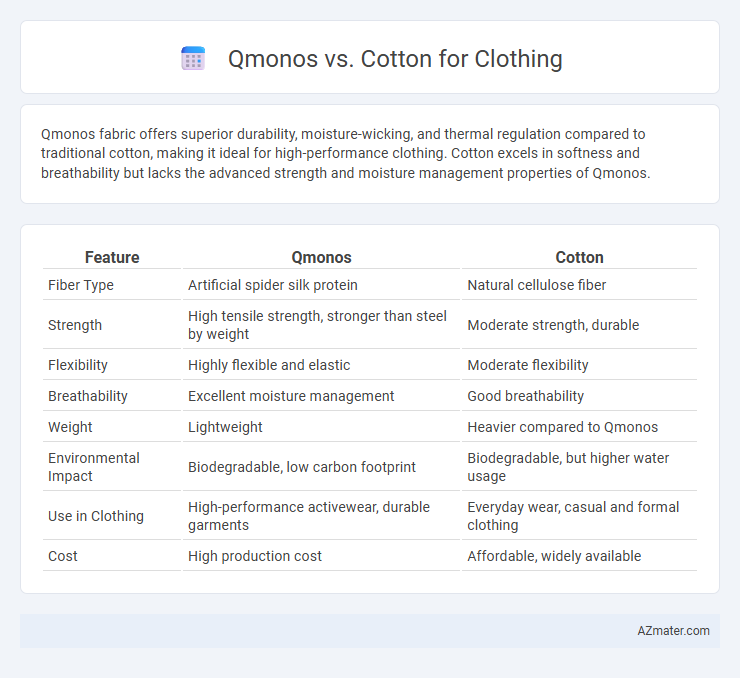Qmonos fabric offers superior durability, moisture-wicking, and thermal regulation compared to traditional cotton, making it ideal for high-performance clothing. Cotton excels in softness and breathability but lacks the advanced strength and moisture management properties of Qmonos.
Table of Comparison
| Feature | Qmonos | Cotton |
|---|---|---|
| Fiber Type | Artificial spider silk protein | Natural cellulose fiber |
| Strength | High tensile strength, stronger than steel by weight | Moderate strength, durable |
| Flexibility | Highly flexible and elastic | Moderate flexibility |
| Breathability | Excellent moisture management | Good breathability |
| Weight | Lightweight | Heavier compared to Qmonos |
| Environmental Impact | Biodegradable, low carbon footprint | Biodegradable, but higher water usage |
| Use in Clothing | High-performance activewear, durable garments | Everyday wear, casual and formal clothing |
| Cost | High production cost | Affordable, widely available |
Introduction to Qmonos and Cotton
Qmonos is a high-performance synthetic fiber derived from nanotechnology, offering exceptional durability, moisture-wicking properties, and resistance to wear and tear, making it ideal for activewear and technical clothing. Cotton, a natural cellulose fiber harvested from cotton plants, is renowned for its breathability, softness, and comfort, widely used in casual and everyday apparel. Both materials serve distinct purposes in clothing manufacturing, with Qmonos providing advanced functionality and cotton delivering natural comfort.
Origin and Production Processes
Qmonos is a bioengineered silk fiber produced through recombinant spider silk proteins, leveraging yeast fermentation for sustainable and scalable manufacturing, originating from advanced biotechnology research. Cotton, derived from the fluffy fiber surrounding cotton plant seeds, undergoes traditional mechanical harvesting and ginning processes rooted in centuries of agricultural practice. The production of Qmonos emphasizes renewable biofabrication with minimal environmental impact, contrasting with cotton's extensive water and pesticide requirements in conventional farming.
Environmental Impact Comparison
Qmonos, a bioengineered spider silk fiber, offers a significantly lower environmental impact compared to traditional cotton, requiring less water and land for production. Cotton cultivation demands high volumes of pesticides and fertilizers, contributing to soil degradation and water pollution, whereas Qmonos is produced in controlled bioreactors, minimizing chemical runoff. The biodegradability of both fibers contributes to reduced textile waste, but Qmonos' sustainable manufacturing process positions it as a more eco-friendly alternative to conventional cotton.
Durability and Strength
Qmonos fibers exhibit exceptional durability and tensile strength, making them significantly more resistant to wear and tear compared to traditional cotton fabrics. Unlike cotton, which can degrade and lose integrity after repeated washing and heavy use, Qmonos maintains its structural integrity due to its synthetic spider silk composition. This superior strength-to-weight ratio offers long-lasting performance ideal for clothing subjected to rigorous conditions.
Comfort and Wearability
Qmonos fibers offer superior moisture-wicking properties and enhanced breathability compared to traditional cotton, resulting in increased comfort during extended wear. The fabric's natural stretchability and lightweight texture improve wearability by allowing better freedom of movement and reducing skin irritation. Cotton remains favored for its softness and hypoallergenic qualities, but Qmonos excels in active wear scenarios where durability and moisture management are critical.
Breathability and Moisture Management
Qmonos fabric excels in breathability due to its advanced microfibers that allow superior air circulation, preventing heat buildup during wear. Its moisture management technology rapidly wicks sweat away from the skin, enhancing comfort and reducing dryness time compared to traditional cotton. Cotton, while naturally breathable, tends to absorb moisture and retain it longer, which can lead to a damp feeling and slower evaporation rates.
Allergenicity and Skin Sensitivity
Qmonos fabric, derived from genetically engineered silkworms, offers hypoallergenic properties that significantly reduce allergenicity compared to conventional cotton, making it ideal for sensitive skin. Unlike cotton, which may harbor pesticides and produce irritation due to its natural fuzz, Qmonos provides a smooth, protein-based fiber less likely to trigger allergic reactions. Studies show Qmonos maintains skin comfort and minimizes inflammation, positioning it as a superior textile choice for individuals with eczema or other dermatological sensitivities.
Cost and Economic Considerations
Qmonos fiber offers a high-performance alternative to conventional cotton with enhanced durability and tensile strength, potentially reducing long-term replacement costs despite a higher initial price. Cotton remains economically favorable due to its widespread availability and lower upfront expenses, making it a cost-effective choice for mass-market clothing production. Evaluating total lifecycle costs, including durability and maintenance, is crucial when choosing between Qmonos and cotton for apparel manufacturing.
Applications in Fashion and Textiles
Qmonos fibers offer exceptional strength and elasticity, making them ideal for high-performance activewear and durable fashion pieces requiring resilience and flexibility. Cotton remains preferred for everyday apparel due to its breathability, softness, and moisture absorption, enhancing comfort in casual and formal wear. Combining Qmonos with cotton can produce hybrid textiles that benefit from the natural comfort of cotton and the advanced durability of Qmonos, expanding innovative applications in sustainable and functional fashion.
Future Prospects and Innovations
Qmonos, a spider silk-inspired fiber, offers superior strength, elasticity, and biodegradability compared to traditional cotton, positioning it as a game-changer in sustainable textiles. Innovations in bioengineering and scalable production techniques are driving Qmonos toward mainstream adoption, promising high-performance, eco-friendly clothing options. Future prospects include enhanced durability, moisture-wicking properties, and reduced environmental impact, which could revolutionize fashion and technical apparel industries.

Infographic: Qmonos vs Cotton for Clothing
 azmater.com
azmater.com